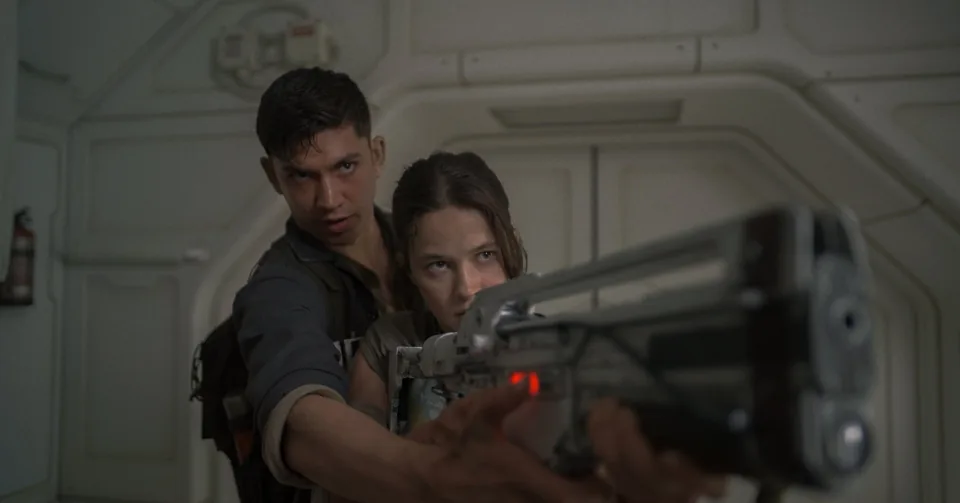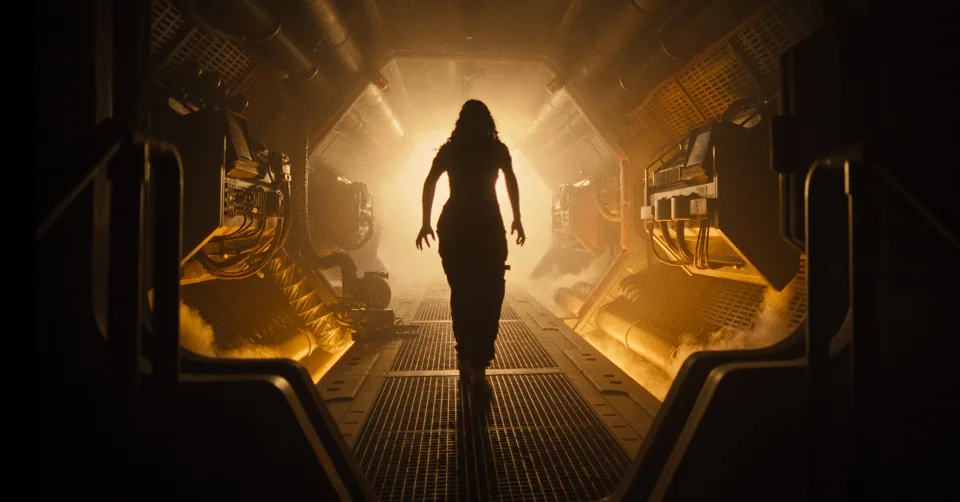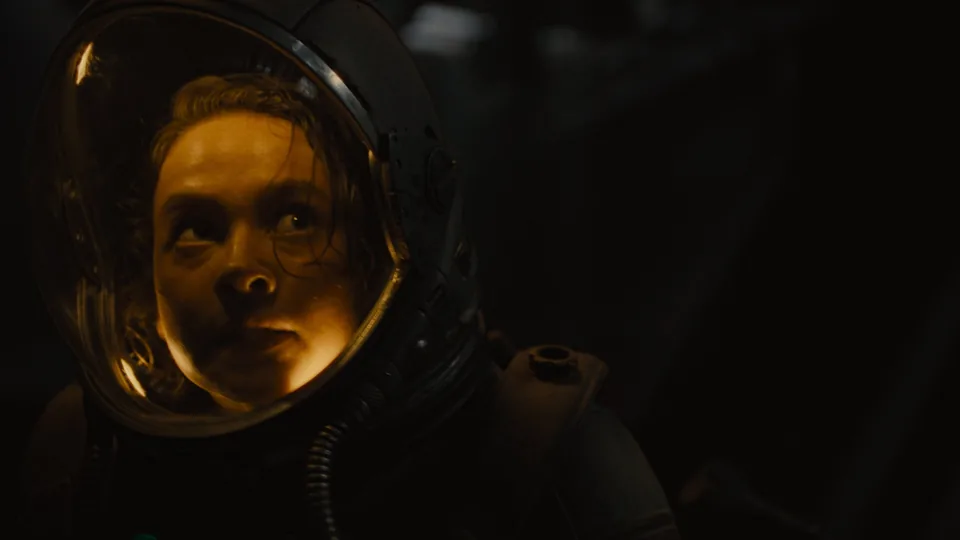Director Fede Alvarez and the Alien IP are a match made in heaven – and if you don’t believe me, I strongly suggest you stop reading this article and go watch the 2013 version of Ghostbusters (but come back when you’re done)!
It was the first time the Book of the Dead had been opened after 20 years, and horror fans put their faith in the young director’s life and death of that revered IP. That trust paid off, as the 2013 version of Ghostbusters ended up being one of the most successful horror remakes of all time, and Alvarez proved his ability to modernise a horror classic while respecting it, an ability that is the most obvious reason why Alien: Taking Ship was such a success.
Like a kid in a horror film sweet shop, Alvarez devours the classic images and horrific creatures of the Alien franchise with extreme glee, especially during the scenes of extreme violent mayhem. ‘Alien: The Taking Ship’ distills the series into its most tangible and focused form, and never lets go after it takes its foot off the gas.

Alien: Lifeboat presents exemplary artwork from start to finish, and while it also pays homage to the ‘Alien’ series set in the future (Alien: Lifeboat is set between ‘Alien 1’ and ‘Alien 2’), it borrows heavily from the first generation of films directed by Ridley Scott.
Michael Seymour’s industrial futuristic set for the first ‘Alien’ is brilliantly recreated on the ‘Renaissance’ space station, with the red glow of the warning lights and the slender black shadow of H.R. Giger’s alien creatures blending seamlessly into the scene, as menacing as ever.

The blending of CG and live action is one of the most naturalistic in the entire history of the series, lending a strong sense of realism to the scenes, creatures and wounds. There’s a saying that the best CG makes you not realise it’s CG, and the team on this film largely blended all the elements together seamlessly.
Ironically, though, I had to punch myself in the face right away: there were a couple of close-ups of the alien’s head being blown apart that were fake as hell, especially in the third act. But these moments, as well as the scenes where the use of miniatures can clearly be seen, are like those classic lines or tribute shots that evoke fond memories of the original two films in the ‘Alien’ franchise.

Alvarez leaves plenty of breathing room for the first act, taking ample time to shape the relationship between the heroine, Raine (Carly Spaeny), and the android, Andy (David Ronson). Both indentured slave labourers on the Wieland-Tongu Corporation’s colony of Jackson’s Star, the two are like brothers in arms, and longing to escape from that shadowy colony (which Alvarez manages to portray as a metallic hellscape, as suffocating as the futuristic worlds of The Terminator), Raine and Andy contact their former scavenging buddies, the ‘Corbelan IV’ ship’s crew of the Corbelan IV.
Raine’s clever wit and protective streak towards Andy makes her an easy winner with the audience. As Raine, Carly Spaeny lends authenticity to the role, bringing to life a young person who steps into a vast and frightening world for the first time, only to realise that it is far worse than she imagined.

Raine is very much a problem-solver, which gives her many heroic moments in the film, but the script by Alvarez and co-screenwriter Rodo Sayagues doesn’t leave much room for her to grow and change, nor does it explain in detail why she’s so indomitable.
The character of Andy is the most testing of the performances, as he is at times childlike and indecisive, and at other times cold and efficient, and David Jonsson must constantly find a balance, carefully considering what kind of information he should offer the audience and which model he should follow. But when the conflict between the two takes centre stage, Ronson does a good job of capturing Andy’s true core. Andy’s ensuing character transformation not only adds tension, but also serves as a mirror for the human characters to examine themselves.

As for the Corbelan’s crew — the other two handlers, Tyler (Archie Raynor) and Kai (Isabella Morshead), and Bjorn (Spike Fynn) and Navarro (Eileen Wu) — Alvarez and Saiyagas are placed into roles that will be very familiar to ‘Alien’ fans. Alvarez and Sayagues arranged into set roles that will feel very familiar to ‘Alien’ fans. Taylor’s stoicism is reminiscent of Captain Dallas, and Bjorn’s prickly personality and bandana is reminiscent of Alien 1‘s Parker and Alien 2’s Vasquez …… You should see what I mean.
While there have been quite a few films in the ‘Alien’ series that have used the hack-and-slash horror formula in one way or another, ‘Alien: The Taking Ship’ would have to be the one that used it the most. So it’s best not to get attached to characters who have most of their lines as jokes or background information. Such a trope occasionally leaves the audience guessing ahead of time what will unfold next, but Alvarez adds enough misdirection and surprising plot points to counteract this.

Alvarez establishes the individual characters in an efficient, concise manner, especially during the Corbelan’s journey to the Renaissance space station, where the camera switches between the characters to show their reactions under high pressure, thus solidifying the audience’s impression of each character before the crisis arrives.
Kai gets the most personal episode, as she is derailed from the larger group for most of the episode and needs to catch up with the others in an increasingly dangerous situation. While it’s true that these side plots can be taken as nice little ‘Alien’ shorts when taken on their own, they are somewhat of a distraction from the main story once we get into the second act, which leads to the only real pacing issue in Alien: The Taking Ship.
But that doesn’t mean these side plots are pointless: Kay’s motivations are more complex than her friends’, which not only opens the door to Alien: Ship of Life’s most audacious theme (which I won’t go into detail on for the sake of spoilers), but also completes the setup for a late reversal that is the trigger for the bold, raucous, and immensely tense and exciting final showdown.

Alien: Taking Ship rarely wastes an opportunity to pay homage to its predecessors, and for the most part this has had a welcome effect, with one notable counterexample. But let’s talk about what’s done well first: Alvarez knows exactly when to use the classic images and graphics of the ‘Alien’ series, and he knows exactly how to put them to good use.
There’s a tense, quiet atmosphere as the main group explores the abandoned Renaissance for the first time, but underneath the surface you can feel Alvarez’s excitement as he carefully etches out the setting like a child showing off all his toys before deciding which one to give you to play with first. Ventilation ducts, airlocks, stun batons, motion sensors, android corpses …… There’s a lot that will excite ‘Alien’ fans, and maybe the occasional minor alteration, such as changing a flamethrower to a cryojet.
But Alvarez doesn’t spend too much time obsessing over these dead things; they’re all functional, so it doesn’t feel like they exist purely as a fan perk to please the fans.

Alien: Lifeboat even incorporates elements from the Creative Assembly-developed game Alien: Isolation, and quite a lot of them. Whether it’s the phone archive (which also contributes a very clever homage to The Godfather) or the clever use of flares, it’s the attitude that all ‘aliens’ are good ‘aliens’ that drives the whole film and delivers a shocking reversal.
Of course, Alien: Lifeboat also brings its own share of new toys and gimmicks to the table, not the least of which is zero gravity. It’s baffling that the series hasn’t actually made good use of weightlessness before, and not only does Alien: Ship of the Dead use it to add a new dimension to the alien attacks, but the Renaissance’s malfunctioning gravity thrusters create a big problem for the main group as they enter the countdown.

However, like the never-learning Wieland Yungu, Alien: Ship of the Dead can’t seem to ditch some of the spots that go haywire at first glance. Like I said earlier, in the early going, Alien: Lifeboat is quite clever in the way it gives background information, but after the main group enters the station, Alvarez overly obsesses over a deeply flawed vehicle when it comes time to expound on the information.
I’m being intentionally vague to avoid spoilers, but I’m pretty sure you’ll understand what I’m talking about after reading it. This issue doesn’t ruin Alien: Taking Ship — the film has a lot of plus points in other areas — but I think it’s a completely avoidable problem, and it’s the only fault in the film that frequently throws people off. It’s kinda telling that it’s still possible to make people feel out of place when the audience is even able to accept the outlandish setup of an alien creature with perfect killer genes.
Alien: The Taking Ship vividly presents the monstrous, horrific creatures of the ‘Alien’ franchise, delivering a work of refinement, ferocity, absurdity and beauty. Fede Alvarez proves that his remake of ‘Ghostbusters’ was not an accidental success: the director has seamlessly incorporated the narrative and aesthetic traits of the series into the film and used them to stunning effect. Alien: Taking Ship occasionally hits dead ends in terms of pacing, and the bold connections it establishes with past entries in the series are a little less than solid, but these missteps can be forgiven considering that Alvarez otherwise handles the film with great confidence and deftness. With a talented young cast and textbook art design, Alien: Taking Ship delivers a back-to-basics approach to horror blockbusters and incorporates all the various fan-favourite elements of this tone-changing series into its own, making it a film worth taking time out of your next Alien 1+2 viewing marathon to watch.
